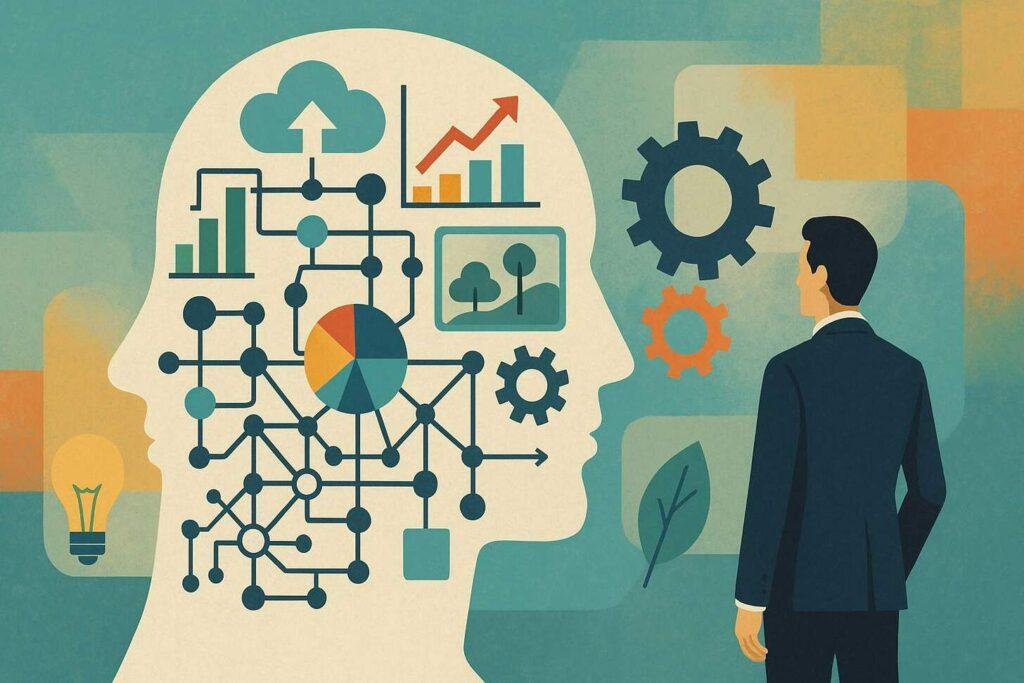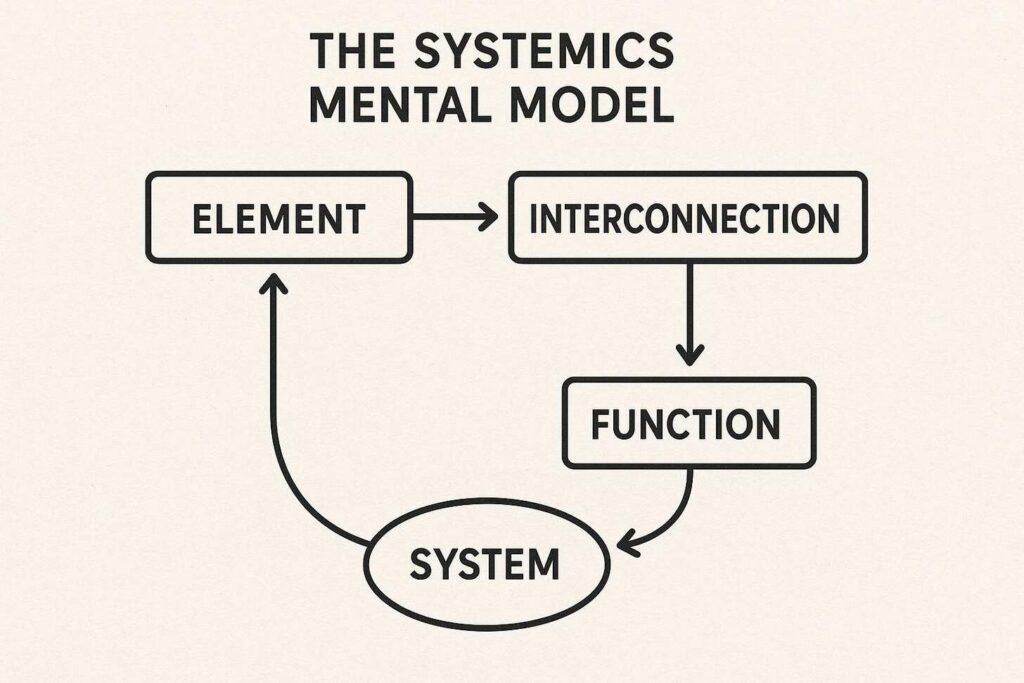Have you ever wondered how everything connects in a system? The systemics mental model helps us see these invisible threads. It’s a way to understand how relationships, feedback loops, and unexpected outcomes shape complex problems.
Think of it like a map for navigating how small changes can create big ripples.
Why does this matter? McKinsey found that 70% of major changes fail when teams ignore how parts of a system interact. For example, a hospital might focus only on reducing wait times but overlook how staffing shortages affect patient care. Meanwhile, a 2022 MIT Sloan study showed leaders using this approach boosted project success rates by 30%.
This framework isn’t just for experts. Imagine redesigning a supply chain: fixing a shipping delay in one area might cause backups elsewhere. By seeing the whole picture, you avoid costly surprises. It’s like solving a puzzle where every piece influences the others.
Key Takeaways
- Focuses on connections, feedback loops, and unexpected outcomes in complex systems
- 70% of change efforts fail when system dynamics are ignored (McKinsey)
- MIT Sloan found a 30% boost in project success with systemic thinking
- Used in healthcare, supply chains, and organizational planning
- Helps anticipate ripple effects to reduce unintended consequences
Foundations of the Systemics Mental Model
What makes complex systems tick? Let’s break down three key ideas that help us understand how models and people influence each other over time, which is a crucial point in this article on system development.
Core Building Blocks
Mental models are like personal roadmaps. They shape how we see problems based on past experiences. For example, a manager might assume “more staff = better service,” but that’s not always true in real systems.
Feedback loops work like a thermostat. When a store discounts products to clear inventory (action), it might attract more buyers (reaction), creating a balancing loop. But if the discount lasts too long, it could train customers to wait for sales—a reinforcing loop with unintended effects.
| Concept | What It Means | Real-World Example |
|---|---|---|
| Emergent Behavior | Unexpected outcomes from many interactions | Traffic jams forming without accidents |
| Time Delays | Gap between action and visible result | Six-month wait to see policy changes in sales figures |
| System Boundaries | What’s included/excluded in analysis | Studying school performance without considering family income |
Systemics Mental Model: When Connections Surprise Us
A bakery chain once expanded too fast. Their model predicted “more stores = higher profits.” But they didn’t account for delivery delays between locations. Soon, fresh bread arrived late at new stores, hurting reputation. This shows why timing matters in dynamic systems.
Can you spot how small changes in your work might create bigger effects? Maybe a quick email reply speeds up three other tasks. That’s systems thinking in action!
Impact on Organizational Change

Why do 7 out of 10 big company changes crash and burn? McKinsey’s famous 70% failure rate often traces back to one critical oversight: treating departments as isolated units rather than interconnected parts. Harvard researchers found this silo mindset can slash performance by 25%—like trying to fix a flat tire without checking the engine.
Addressing Change Failure: Lessons from McKinsey and Harvard
Traditional plans often miss hidden connections. When Kaiser Permanente redesigned patient care, they didn’t just tweak doctor schedules. They mapped how lab results, pharmacy workflows, and follow-up calls interact. Result? A 22% drop in hospital readmissions in 18 months.
Toyota’s supply chain overhaul shows this understanding in action. Instead of just speeding up factories, they adjusted ordering patterns, delivery routes, and warehouse staffing together. This holistic process cut costs by 14% while improving delivery times.
Applications in Healthcare and Supply Chain Management
Three things separate successful changes from failed ones:
- Tracking how decisions ripple across teams
- Testing small adjustments before full rollout
- Using real-time data to spot bottlenecks
What if your team could predict how a new policy affects customer service, production, and budgets simultaneously? Start by mapping key connections in your next project. Ask: “Where might quick fixes backfire?”
Practical Ways to Use Systemic Thinking

What if you could unlock hidden potential in your projects by seeing connections others miss? Teams using the systemic mental model consistently outperform traditional methods. MIT Sloan’s research proves it—their study showed a 30% boost in success rates when groups mapped how decisions ripple through entire workflows.
Improving Project Success with Systemic Approaches
Successful teams follow three steps.
First, they identify all stakeholders and processes involved. For example, a healthcare network reduced patient readmissions by 20% by tracking how discharge plans affected home care and pharmacy visits.
Second, they test small changes first.
Third, they update plans using real-time feedback.
Key features of this method include visual mapping tools and cross-team workshops. These help spot hidden dependencies early. For example, an e-commerce company avoided warehouse bottlenecks by adjusting their inventory development timeline based on supplier lead times.
Designing Robust Solutions to Avoid Unintended Consequences
Kaiser Permanente’s care redesign shows how knowledge sharing prevents problems. Nurses, doctors, and administrators co-created protocols that accounted for lab delays and family expectations. The result? Fewer medication errors and happier patients.
Want to try this? Start your next meeting by asking: “What connections are we missing?” Then use color-coded diagrams to show how tasks interact. Teams using these systemic approaches report 40% fewer last-minute crises according to recent case studies.
How might seeing the whole picture transform your team’s experience? Could anticipating three-step ripple effects turn good plans into great outcomes?
Systemic Mental Model in Decision-Making

Strategic decisions shape our world every day. But how do leaders ensure choices align with complex realities? A Porticus Foundation study found teams using shared frameworks made 40% fewer costly errors. The key lies in bridging different views of how reality works across departments.
Creating Shared Understanding Across Teams
Aligning stakeholders starts by mapping their unique perspectives. One tech firm used workshops to reveal conflicting assumptions about customer needs. By visualizing these differences, they designed solutions addressing 90% of user pain points. Three steps make this work:
- Host cross-functional “reality mapping” sessions
- Use visual tools to compare mental maps
- Identify overlaps to build common ground
Data-Driven Insights in Action
MIT Sloan’s 2023 report shows data-literate companies outpace peers by 2:1 in decision speed. But raw information isn’t enough. A healthcare network combined patient feedback with supply chain metrics to redesign care pathways. This holistic way reduced costs 18% while improving outcomes.
| Approach | Result | Key Lesson |
|---|---|---|
| Weekly alignment check-ins | 22% faster approvals | Regular syncs prevent drift |
| Shared dashboards | 35% fewer conflicts | Visible data builds trust |
| Scenario testing | 41% better risk management | Practice reveals blind spots |
Want to transform your team’s way of working? Start small. Map one process with input from every part involved. Notice where assumptions clash with actual data. Ask: “What reality are we missing here?”
True alignment turns fragmented views into powerful information systems. Are you ready to see the full picture when deciding your next move?
Mental Models: From UX to System Dynamics
How do invisible patterns shape our interactions with technology and teams? Designers and engineers use similar principles to predict behavior—whether building websites or corporate training programs. Jakob Nielsen found users form interface expectations in under 0.1 seconds. That’s faster than blinking!
Insights from User Interface Design and Mental-Model Inertia
Ever tried clicking where a button “should” be? That’s mental-model inertia—our brains cling to familiar patterns. Online shoppers expect carts in the top right. Move it, and purchases drop 18% (Nielsen Norman Group). Organizations face similar challenges: teams resist new processes that clash with existing experiences.
A bank redesigned its loan approval system but kept the old layout. Why? Employees’ muscle memory mattered more than shiny features. Small tweaks that align with ingrained behavior work better than overhauls.
Integrating Cognitive Maps into Organizational Learning
Johnson-Laird’s research shows we build “cognitive maps” to navigate complex decisions. Tech companies now use this idea in onboarding programs. New hires get visual flowcharts showing how their role connects to engineering, marketing, and support teams.
Try this: Sketch how your last big decision affected three departments. Notice gaps? Training teams that map these connections report 27% faster problem-solving (2023 Training Industry Report).
How do your experiences with apps influence how you lead meetings? Cross-disciplinary insights reveal surprising parallels. Next time you design a workflow, ask: “What invisible rules are we assuming here?”
Conclusion
How can we make better decisions in a connected world? The systemics mental model turns invisible connections into clear paths forward. Teams that map relationships between departments, suppliers, and customers see 30% fewer costly surprises—just like MIT’s research showed.
Every action matters. When Kaiser Permanente redesigned care protocols, they didn’t just improve patient outcomes—they transformed how lab techs, nurses, and families collaborate. Your team could achieve similar results by asking: “What three-step ripple effects might this decision create?”
Three quick actions to start today:
- Host cross-department workshops to spot hidden dependencies
- Use simple diagrams to show how tasks interconnect
- Celebrate team members who anticipate downstream effects
Remember—each role shapes organizational resilience. From frontline staff to executives, we all contribute to the bigger picture. Schools teaching systems thinking report students solving complex problems 40% faster. Why not bring that power to your workplace?
Ready to transform how your team operates? Explore our practical guides to turn these ideas into daily practice. After all—isn’t it time to see your challenges as interconnected opportunities?


